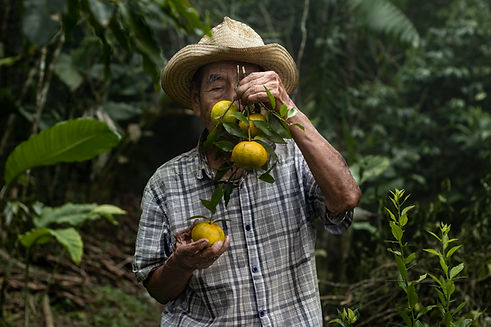

Welcome to
veracruz
location

veracruz
México
Océano
Pacífico
Golfo de México
Guatemala

Our presence in Veracruz

Hectares
Coffee producers
56
45
Average farm size per producer (Ha)
Men
Women
1.2 ha
33
12
Communities
24
Coffee production in Veracruz

2
Production in Veracruz during the 2019-2020 harvest was 956K bags (60kg)
Veracruz contributes to 24% of the national production
place
1,1
Average farm size
hectares
Varietals
Typica, Oro Azteca, Sarchimor, Gesha and Anacafé 14
90%
of the coffee is washed *estimated*
500-2,000
ms.n.m
Source: Café de México: estados y sus regiones / Revista Fitotec México / Secretaría de Agricultura y Desarrollo Rural.

Production systems in Veracruz

5
40
30
20
10
1.0%
Forest system
31.5%
Traditional polyculture
12.2%
Commercial polyculture
54.3%
Shade-grown monoculture
1%
Full-sun monoculture
*Height in meters
Source: https://www.revistas.una.ac.cr/index.php/historia/article/view/3436/3294
100% of the farms we buy coffee from are traditional polyculture systems

Indigenous languages in Veracruz
8,062,579 total speakers
359,173
population
125,895
population
56,164
population
33,787
population

Populoca de Sierra
19,482
population
18,740
population
Otomí
Zapoteco
Huasteco
Náhuatl
Totonaco
The coffee producers we work with are primarily native speakers of Nahuatl.
Culture and tradition
1
The regions of Huasteca, Zongolica, and Chicontepec stand out as the heart of cultural heritage. These regions are the epitome of distinguished traditions, including Día de Muertos (Day of the Dead) and La Candelaria. Moreover, they are known for their exceptional craftsmanship and textile art.
2
The Xochitlalis (Xochitl: flower, Tlali: root), which means "flowers for the earth" in the indigenous Nahuatl language, is a ritual performed by farmers in Zongolica to express gratitude to the earth and seek abundant harvests and a sufficient water supply. The ceremony is celebrated with food, drinks, and music.
3
The xochicoscatl and xochitlamanali, which translate to "flower necklace" or "flower bouquet" in the Nahuatl language, correspond to a ritual conducted in the Sierra de Zongolica to welcome guests during social events or religious festivities. It involves placing a crown and a flower necklace on the honored guests.


Agriculture and economy
Veracruz is the second biggest food supplier in Mexico with tan annual production of 31 tons of food. The most widely produced crops are coffee, sugarcane, maize, orange, lemon and pineapple.
Veracruz is widely recognised for its significant contribution to the agriculture, livestock, fishing, and beekeeping sectors. Beekeeping, in particular, plays a vital role, engaging approximately 400,000 families, especially in regions such as Huasteca Baja, Totonacapan, Altas Montañas, and the Sotavento.
Challenges in Veracruz

Veracruz is the fifth state in Mexico with the highest poverty rate, with 62% of its population living in poverty (16% in extreme poverty and 44.8% in moderate poverty)
With approximately 8.49% of their population being illiterate, Veracruz is one of the states in Mexico with highest level of educational deprivation.
Almost 30% of the population in Veracruz lacks access to public healthcare or free medications, an extremely concerning situation.
In coffee-producing areas, coffee farmers are offered low prices for the sale of their agricultural products.
The lack of access to market and financing for coffee farmers leads to poor farm management which negatively impacts the yields. The absence of coffee tree renovation means most plantations are old and very vulnerable to pests, diseases, and climate change, further impacting the yields.
Ensambles regenerating

We provided technical training, purchased coffee, and connected around 45 producers from Veracruz to national and international markets.
- 12 women
- 33 men
We worked with 56 hectares of coffee-growing land owned by small producers and supported about 24 indigenous communities.
We set up a storage facility, and in our central tasting lab in Coatepec, Veracruz, we evaluated over 380 coffee samples from the region.
We helped improve the family income of our partner producers by paying 65% above local prices.
In partnership with Kaffeemacher and the IBT, we launched the Tlapajti project (which means “to heal” in Nahuatl) in the Zongolica Mountains to help producers obtain their organic certification. We also helped more than 15 producers to organise themselves into Rural Production Societies, strengthening their legal structure.
27% of our network consists of indigenous women producers, who are starting to play a more active role in coffee farming in this region.
We promoted coffee production under agroforestry and biodiversity-friendly systems that offer environmental services, protect ecosystems, and help fight climate change.
In collaboration with NUUP, we are training and implementing the Sirio platform to georeference coffee plots and prepare for the European Union’s anti-deforestation regulation. At the same time, we’re helping producers from the Zongolica area to obtain their organic certification.

